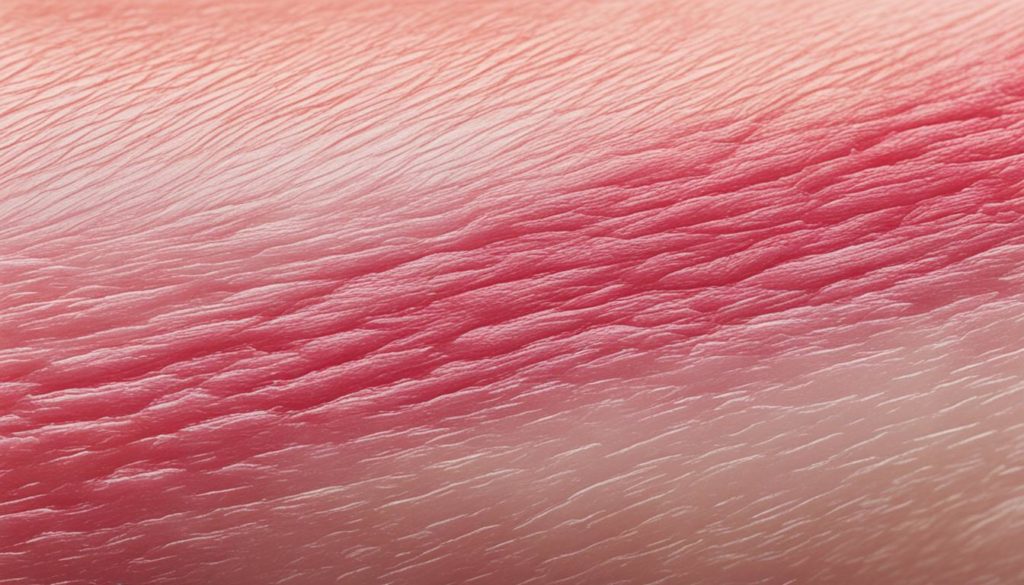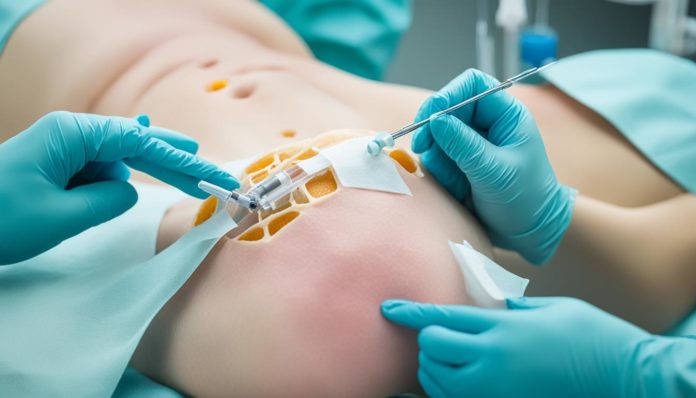Did you know that up to 1 in every 1,000 people will get an epidermoid cyst? These are non-cancerous lumps under the skin. Spotting the symptoms early is key to handling them well. Getting the right treatment helps avoid problems like infections and scars. It’s important to know what causes these cysts and how to treat them.
Key Takeaways
- Epidermoid cysts affect up to 1 in every 1,000 people.
- Recognizing the symptoms early can help in managing epidermoid cysts effectively.
- Various treatment options are available, including non-surgical methods and surgical removal.
- Proper treatment of epidermoid cysts can prevent complications such as infection and scarring.
- Understanding the causes and risk factors is crucial for managing this condition.
What Are Epidermoid Cysts?
Epidermoid cysts are non-cancerous lumps under the skin. It’s important to know what they are to treat them right. They appear mostly on the face, neck, and body. These cysts grow slowly.

Epidermoid Definition
An epidermoid tumor is a harmless lump that starts from skin cells. The lining of these cysts is special because it makes keratin. This keratin gathers inside, making the cyst look and feel a certain way.
Common Characteristics
The characteristics of epidermoid cysts include their slow growth. They are smooth and round. Usually, they don’t hurt but can get swollen or infected.
These cysts move when you touch them. Sometimes, you can see a tiny hole on their top.
Common Symptoms of Epidermoid Cysts
Knowing how to spot signs of epidermoid cysts is key for quick help. They usually look like small, round lumps under the skin, often found on the face, neck, or torso. A typical epidermoid symptom is a lump that varies in size, from tiny to big.
“An accurate overview of the common symptoms can aid in the early detection of epidermoid cysts.”

- Painless Lumps: Many of these lumps don’t hurt. People might find them when checking their skin.
- Swelling: The skin near the cyst could swell, making the lump more noticeable.
- Tenderness: Sometimes, the cysts feel tender, especially if they’re swollen or infected.
Symptoms of epidermoid cysts can change. Some cysts stay the same size, while others get bigger because they fill up with keratin. When they’re infected, they turn red and warm, and hurt more, which means it’s time to see a doctor.
- Gradual Growth: Most of these cysts grow slowly. They get bigger over months or years.
- Firm Texture: They usually feel hard because they’re full of keratin, a type of protein.
- Skin Changes: The skin around the cyst might change color or get thinner with time.
By understanding these symptoms, people can get medical advice early. This can help avoid issues from cysts that are not treated.
Causes and Risk Factors of Epidermoid Cysts
Epidermoid cysts are non-cancerous lumps that can appear on your skin. Knowing what causes them and the risk factors is key to stop and manage them. They form because of genetics and things around us.
Genetic Factors
Genes play a big role in getting epidermoid cysts. Changes in genes or certain inherited diseases make cysts more likely. For example, people with Gardner’s syndrome have a higher chance of getting many cysts. Some families are more likely to get them, showing it can be passed down.
Environmental Triggers
Even though genes are important, things around us can make cysts form too. Injuries to the skin can lead to cysts. Also, infections or swelling in hair follicles can cause them. This shows why taking care of our skin is crucial to avoid these cysts.
Diagnosing Epidermoid Cysts
To make sure you get the right treatment, it’s important to diagnose epidermoid cysts correctly. This involves doing a detailed medical check-up and some tests. These steps confirm what kind of cyst it is.
Medical Examination
A health expert will take a close look at the spot during a check-up. They’ll check the cyst’s size, shape, and feel. This is key in figuring out which type of cyst it might be. It also helps decide if more tests are needed.
Diagnostic Tests
For a clear diagnosis, sometimes extra tests are done. These tests include:
- Ultrasound: This test shows what the cyst looks like inside. It helps tell it apart from other types.
- CT Scan or MRI: These give a detailed view. They show how deep the cyst is and its effect on nearby tissues.
- Biopsy: If it’s not clear what it is, a biopsy can help. It checks the cyst material under a microscope.
These tests really help in making sure the diagnosis is right. They guide doctors on the best way to treat it, either through surgery or other means.
Effective Treatments for Epidermoid Cysts
There are many ways to treat epidermoid cysts, from simple to complex methods. What’s best depends on how serious the cyst is, any symptoms, and what the patient prefers.
Non-Surgical Methods
There are non-surgical ways to ease epidermoid cysts and stop infections. Doctors might recommend these methods for cysts that are inflamed:
- Steroid Injections: Injecting steroids into the cyst lowers swelling and helps with pain.
- Antibiotics: These fight off infection if the cyst gets infected.
- Warm Compresses: Warm compresses help the cyst drain on its own, avoiding surgery.
Surgical Removal
If other treatments don’t work, surgery might be needed. There are several surgical techniques:
- Incision and Drainage: A small cut is made to drain the cyst. It gives quick relief but might not stop it from coming back.
- Complete Excision: Removing the whole cyst helps prevent it from returning.
- Laser-Aided Excision: This less invasive method uses a laser to take out the cyst, which helps heal faster.
Choosing the best treatment should be a joint decision with your doctor, based on your health needs.
Preventing Epidermoid Cysts
Keeping a steady skincare routine is key for preventing skin cysts. Using good hygiene habits greatly lowers the chance of getting these cysts.
- Cleansing: Use a gentle cleanser to remove excess oil and dirt from the skin.
- Exfoliation: Regularly exfoliate to remove dead skin cells, preventing clogged pores.
- Moisturization: Keep the skin properly moisturized to maintain its natural barrier.
Learning about skincare helps a lot in preventing skin cysts. Choose products wisely. Look for those labeled non-comedogenic. Avoid strong chemicals that could harm your skin.
| Skincare Practice | Benefit |
|---|---|
| Cleansing | Removes dirt and oil, preventing pore clogging |
| Exfoliation | Eliminates dead skin cells |
| Moisturization | Maintains skin’s protective barrier |
Complications Associated with Epidermoid Cysts
Understanding epidermoid cyst complications is crucial for anyone looking into treatment. These cysts are mostly harmless. However, they can cause major problems if not handled right.
Infection Risks
Infections are a big issue with epidermoid cysts. An infected cyst can hurt a lot and may form abscesses. Keeping clean and getting medical help quickly is key to lowering these risks.
Scarring and Recurrence
Scarring and the cyst coming back are also big worries. Surgery often works best for removal. But the wrong surgical method can make infection and scarring worse, ruining the look. Also, not taking the whole cyst out can make it likely to return. For more info, check this medical resource.
It’s very important to get advice from a doctor to watch and pick the right surgical method. This way, you can lower the chances of infection and scarring. It also helps get better results in the end.
Epidermoid vs. Other Types of Cysts
It’s important to know how epidermoid cysts differ from pilar and sebaceous cysts. Understanding these differences is key for proper care. We will explore the unique traits of each, making their differences clear.
Pilar Cysts
Pilar cysts, also known as trichilemmal cysts, are mostly found on the scalp. They appear mainly in middle-aged women. These cysts form from hair follicles.
They’re round, smooth, and filled with keratin. Mostly, pilar cysts are safe and painless. Yet, they can become bothersome if they get too big or infected.
Sebaceous Cysts
Sebaceous glands, which keep the skin moist, give rise to sebaceous cysts. They’re mostly spotted on the face, neck, and torso. Even though they look like epidermoid cysts, sebaceous cysts hold a yellow, oily substance.
They’re more likely to get infected than other cysts. So, it’s wise to seek medical help quickly.
| Cyst Type | Origin | Common Locations | Typical Contents | Infection Risk |
|---|---|---|---|---|
| Pilar Cysts | Hair Follicles | Scalp | Keratin | Low |
| Sebaceous Cysts | Sebaceous Glands | Face, Neck, Torso | Oily Material | High |
| Epidermoid Cysts | Epidermal Cells | Face, Neck, Trunk | Keratin | Moderate |
Knowing the type of cyst is crucial for the right treatment plan. By identifying the cyst type, doctors can offer better care. This approach makes treatment more effective.
When to See a Doctor for Epidermoid Cysts
Knowing when to get medical advice for cysts is key. Epidermoid cysts are usually safe but some symptoms are worrying. These symptoms mean you should see a doctor.
One sign is if the cyst grows quickly. Rapid growth of the cyst might show a serious issue. Then, it’s smart to have a consultation for epidermoid cyst.
When cysts hurt or get infected, it’s time to act. Signs are redness, heat, or pus. Also, cysts in places that move a lot or where clothes rub need a doctor’s look.
If a cyst breaks or gets inflamed, see a doctor quickly. Broken cysts can cause infections, and sometimes, these get very bad. Getting help early is crucial for your skin’s health.
Understanding these signs helps you handle epidermoid cysts well. This way, you can avoid bigger health issues.
Conclusion
Epidermoid cysts are common and need careful management. We’ve covered everything about them in this article. It’s key to know the signs, like a small bump on the skin, for quick action.
Treatments for epidermoid cysts vary from non-surgical to surgical. The best method depends on the cyst’s size and where it’s located. Always talk to healthcare experts to figure out what’s best for you.
It’s critical to handle cysts early to prevent any problems. With the right knowledge and doctor’s help, managing cysts becomes easier. This guide aims to help you understand epidermoid cysts better and when to seek advice.
FAQ
What are the common symptoms of epidermoid cysts?
A small, round bump under the skin is a common symptom. It may not hurt. Other signs include swelling, redness, or tenderness, especially if it gets inflamed or infected.
What causes epidermoid cysts to form?
They often come from keratin buildup under the skin. Causes include genetic factors, injury to the skin, or other causes. These might be infections or clogged hair follicles.
How are epidermoid cysts diagnosed?
A healthcare professional checks the cyst first. They might also use ultrasounds or biopsies. These help confirm the diagnosis and check for other issues.
What are the available treatment options for epidermoid cysts?
Choices range based on the cyst’s size and state. There are non-surgery methods like steroid shots and antibiotics. There are also surgery options for tougher cases.
How can I prevent epidermoid cysts from developing?
Keeping clean and taking care of your skin helps. Avoid skin injuries. Treating skin problems right away also lowers risk.
What are the potential complications of epidermoid cysts?
Issues can be infections, pain, abscesses, and scars. There’s also a chance it might come back after removal. Proper care and check-ups help avoid these problems.
How are epidermoid cysts different from other types of cysts, like pilar or sebaceous cysts?
Epidermoid cysts are keratin-filled and usually on the face, neck, and trunk. Pilar cysts, with similar protein, often show up on the scalp. Sebaceous cysts, filled with sebum, appear on the back, neck, and face. Each has its own causes, signs, and care methods.
When should I see a doctor for an epidermoid cyst?
See a doctor if it grows quickly, hurts, or Looks infected, like being red and warm. Getting checked early is key for the right treatment and avoiding problems.


